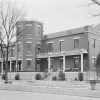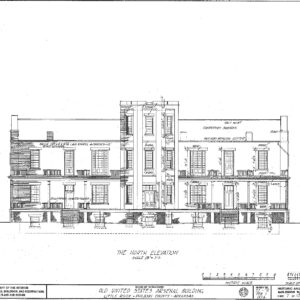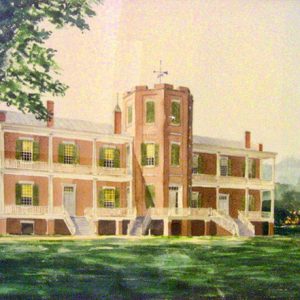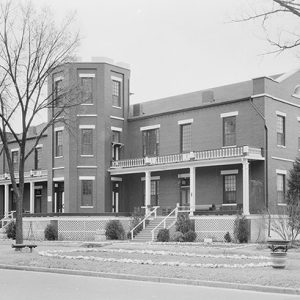calsfoundation@cals.org
Little Rock Arsenal
In 1836, the same year Arkansas was admitted into the Union, the federal government requested the building of a military installation in Little Rock (Pulaski County). Under Governor James Sevier Conway and Major Robert B. Lee, a site for the Little Rock Arsenal was selected on the outskirts of the city. The site was on a former racetrack used by a local jockey club. Originally, Congress had allotted $14,000 for the arsenal, but the final cost of the building was $30,000. It incorporated timbers from Pine Bluff (Jefferson County) and stone from the Big Rock on the north side of the Arkansas River across from Little Rock, as well as locally made bricks. At the arsenal’s completion, the Arkansas Gazette declared it to be “a splendid specimen of masonry.” The arsenal was unique in that it had a center Tower Building, named for its octagon tower. Over the next decade, more than thirty buildings were added to the installation.
Captain James Totten was commander at the arsenal at the beginning of the Civil War. Governor Henry M. Rector was urged by citizens of Arkansas, even before the state formally seceded in May 1861, to seize the installation, but he sought to claim the buildings without violence. Totten wrote to authorities in Washington DC seeking direction, but in the end he was forced to follow his own wisdom. In February 1861, he surrendered the arsenal to the State of Arkansas, and Federal troops left by boat for St. Louis, Missouri. The women of Little Rock saluted his peaceful solution, presenting Totten with a ceremonial sword. In 1863, Federal troops entered Little Rock and occupied the arsenal for the duration of the war. From 1863 to its decommissioning in 1890, the Little Rock Arsenal became more of a housing complex, with weapons stores being replaced with rooms for soldiers and their families.
Douglas MacArthur was born at the arsenal in 1880, during what was a transitional time. After an overview of federal arsenals in the United States, the Department of War decided to close hundreds of military bases. The Little Rock Arsenal was to be abandoned no later than October 1, 1890, per order of the department. Several proposals, including the establishment of a brewery, were made regarding the land and buildings. On April 23, 1892, the City of Little Rock gave the federal government more than 1,000 acres of land north of the Arkansas River (which the government developed as Fort Roots) in exchange for the thirty-six acres around the arsenal and the approximately thirty buildings upon them. The grounds of the arsenal were converted to a public park, first called City Park and renamed MacArthur Park in 1942. All the buildings other than the Tower Building were sold or destroyed.
The Tower Building remained empty and in deteriorating condition until the late 1930s, when the City of Little Rock renovated the building. In 1942, the Museum of Natural History and Antiquities opened in the building; it had previously been located in Little Rock’s City Hall. The name of the museum changed in 1964 to the Museum of Science and Natural History, and again in 1983 to the Arkansas Museum of Science and History. In 1997, the museum moved to a new location in the River Market, where it now is known as the Museum of Discovery.
In May 2001, the MacArthur Museum of Arkansas Military History opened in the Tower Building of MacArthur Park, the last remaining structure of the Little Rock Arsenal. MacArthur Park is also home to the Arkansas Museum of Fine Arts, built in 1937 and enlarged several times since then. A playground, grassy areas, a pavilion, contemplation gardens, and a small lake also occupy the land that once belonged to the Little Rock Arsenal.
The Little Rock Arsenal was listed on the National Register of Historic Places on July 28, 1970, and was named a National Historic Landmark on April 19, 1994.
For additional information:
Eison, James Reed. “The Arsenal in Little Rock.” Pulaski County Historical Review 16 (June 1968): 17–23.
———. “MacArthur Park: Then and Now.” Pulaski County Historical Review 32 (Fall 1984): 51–56.
Huddleston, Duane. “Building the Little Rock Arsenal.” Pulaski County Historical Review 20 (December 1972): 45–47.
“U.S. Arsenal Building.” National Register of Historic Places nomination form. On file at Arkansas Historic Preservation Program, Little Rock, Arkansas. Online at https://www.arkansasheritage.com/docs/default-source/national-registry/pu3150-pdf.pdf?sfvrsn=c9a40f81_0 (accessed April 25, 2022).
Austin Hsu
Honolulu, Hawaii
Staff of the CALS Encyclopedia of Arkansas
 Little Rock Arsenal, Seizure of the
Little Rock Arsenal, Seizure of the MacArthur Park Historic District
MacArthur Park Historic District Little Rock Arsenal Plans
Little Rock Arsenal Plans  Old Arsenal
Old Arsenal  Tower Building
Tower Building 




Comments
No comments on this entry yet.